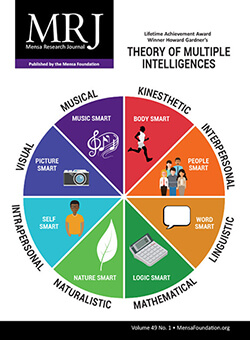Inside the Latest Mensa Research Journal
- Feb 7, 2018
- Steve Slepner, MRJ Editor
 This issue is devoted to the work of Howard Gardner, who is the winner of the Mensa Foundation’s Lifetime Achievement Award.
This issue is devoted to the work of Howard Gardner, who is the winner of the Mensa Foundation’s Lifetime Achievement Award.
Dr. Gardner developed the Theory of Multiple Intelligences (MI). He explains his development of this theory in “The Theory of Multiple Intelligences: As Psychology, As Education, As Social Science.” This is from an address that he gave on receiving an honorary degree from José Cela University in Madrid, Spain, and the Prince of Asturias Prize for Social Science in Madrid, Spain, and has not been published elsewhere.
I have no trouble reconstructing the steps that led to my promulgation of the theory of multiple intelligences (MI theory). At least in retrospect, those seem clear. At the same time, I have no recollection of what may be the most crucial question: how or why I decided to cast my discussion in terms of “intelligences” rather than some less inflammatory characterization. In my remarks today, I will recall how the theory came into being, and then discuss it from the perspective of three different disciplinary areas: As Psychology, as Education, and as Social Science.
In “The Neuroscience of Intelligence…” C. Branton Shearer and Jessica M. Karanian review neuroscience reports for evidence to support the theory. Jung-Ho Jung and Don-Ryun Chang relate design convergence talent (DCT) to multiple intelligences in “Types of Creativity….”
“Ascertaining Concurrent Validity & Reliability…” by Shruti Marwaha and Geetika Seth Nanda tests the validity and reliability of the Multiple Intelligence Level Scale (MILS). Heamalatha Krishnan and Siti Rahmah Awang develop a measurement model of MI in “A Measurement Model of Multiple Intelligence Profiles….” Mohd Azran Mohd Salleh and Siti Nural Mahfuzah Mohamad discuss the use of MI-inspired courseware in a community college in “The Effectiveness of Using Multiple Intelligences Courseware….”
“Teaching Technology…” by Jesus Sanchez-Martin, et al. shows the use of MI in teaching technology. “Characteristics of Patients with Language Disorders…” by Renata Gomes Camargo and Carolina Lisbôa Mezzomo investigate which intelligences in the MI theory affect the development of language.
This is intended as an overview of the current research into Gardner’s theory of multiple intelligences. This research involves not only psychology but also education. I hope you enjoy it.
Published three times yearly, the Mensa Research Journal highlights scholarly articles and recent research related to intelligence from a diverse selection of nationally and internationally esteemed authors. Learn more about the MRJ and subscribe today.
Research featured in this issue
- “The Theory of Multiple Intelligences: As Psychology, As Education, As Social Science,” by Howard Gardner (Google Project Zero)
- “The neuroscience of intelligence: Empirical support for the theory of multiple intelligences?” by C. Branton Shearer & Jessica M. Karanian (Trends in Neuroscience and Education)
- “Types of Creativity — Fostering Multiple Intelligences in Design Convergence Talents,” by Jung-Ho Jung & Don-Ryun Chang (Thinking Skills and Creativity)
- “Ascertaining Concurrent Validity & Reliability of ‘Multiple Intelligence Level Scale’ to trace Multiple Intelligence Level of subjects,” by Shruti Marwaha & Geetika Seth Nanda (International Journal of Advanced Multidisciplinary Research)
- “A Measurement Model of Multiple Intelligence Profiles of Management Graduates,” by Heamalatha Krishnan & Siti Rahmah Awang (AIP Conference Proceedings)
- “The Effectiveness of Using Multiple Intelligences Courseware in Learning Multimedia Subject,” by Mohd Azran Mohd Salleh & Siti Nurul Mahfuzah Mohamad (Advanced Journal of Technical and Vocational Education)
- “Teaching Technology: From Knowing to Feeling—Enhancing Emotional and Content Acquisition Performance Through Gardner’s Multiple Intelligences Theory in Technology and Design Lessons,” by Jesus Sanchez-Martin, Garcia J. Alvarez-Gragera, & Maria Antonia Davila-Acedo, Vicente Mellado (Journal of Technology and Science Education)
- “Characteristics of Patients with Language Disorders and the Theory of Multiple Intelligences,” by Renata Gomes Camargo & Carolina Lisbôa Mezzomo (Revista CEFAC)